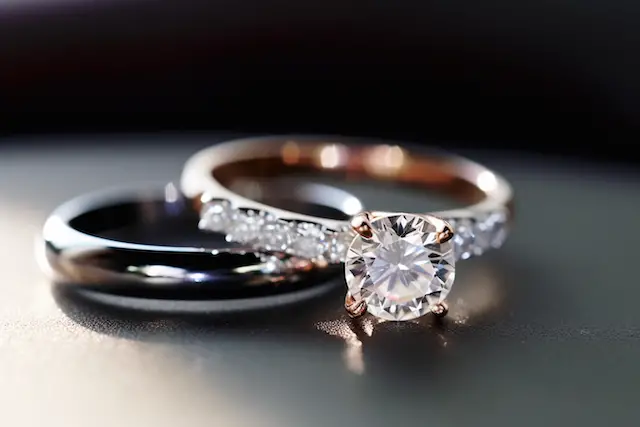How to Insure Your Engagement Ring: A Quick Guide
Amidst all the excitement of planning your future together, learning how to insure your engagement ring so your precious symbol of love is well-protected in the years ahead is essential.
Your engagement ring insurance helps you safeguard it against theft, damage, and other unexpected losses. Here’s a quick guide on how to insure your engagement ring.
Insure Your Engagement Ring As Soon As Possible
Insure your ring as soon as possible after purchase through either your property insurance or a specialized jewelry insurer, ideally right after the ring is purchased and in your possession. This way, you will have the peace of mind that comes with knowing your ring is protected.

How much does it cost to insure an engagement ring
The cost of a specialty jewelry insurance policy for a ring typically ranges from 0.5% to 3% of its appraised value.
This means that if you have a ring worth $10,000, the annual premium could range from $50 to $300.
Jewelry insurance can cover loss, theft, damage, and mysterious disappearance of your precious items.
Again, it’s important to ensure you get the right coverage for your specific needs so you can rest assured knowing that your jewelry is protected in case of an unforeseen event.
Before purchasing a policy, it is crucial you have your engagement ring professionally appraised and keep a copy of the store receipt.
Pro Tip: Additionally, take a picture of your ring to provide visual documentation for the insurance company.
By taking these necessary steps, you can confidently enjoy your engagement, knowing that your precious symbol of love is protected.
Understanding Engagement Ring Insurance
Why it is Important
Financial Protection
Engagement ring insurance protects your valuable asset against physical loss, theft, or damage.
In the unfortunate event of loss or damage, your insurance policy can provide financial relief and help you replace or repair your precious ring.
Peace of Mind
Knowing that your precious symbol of love is protected brings peace of mind.
A ring can hold high sentimental and monetary value, and protecting it through insurance is the best way to ensure your engagement ring remains secure.
Types of Insurance Coverage
There are a few types of coverage to consider:
Jewelry-specific policies: Some insurance companies offer specialized policies designed to cover jewelry items, including engagement rings. These policies typically provide comprehensive protection, covering theft, loss, and accidental damage.
- Pros: High level of protection, tailored to jewelry coverage
- Cons: May have a higher premium compared to adding to your homeowners/renters policy
Adding a Rider to Your Existing Policy: If you already have a homeowners or renters insurance policy, you can add a rider (or endorsement) that covers your engagement ring. This can be a convenient and cost-effective means of insuring your valuable possession.
- Pros: Lower cost and easy addition to your existing insurance policy
- Cons: Limited to the scope of your homeowners or renters insurance; may not cover all types of incidents
Standalone insurance policies
Standalone insurance policies are specifically designed to provide coverage for high-value items such as engagement rings. In addition, these policies offer comprehensive coverage for loss, theft, and damage and can be customized to suit your specific needs.
Standalone policies are generally more expensive than other policies but offer better coverage.
- Pros:
Specialized Coverage: Standalone policies are designed for jewelry, ensuring comprehensive coverage for your engagement ring, including theft, damage, and loss.
Higher Limits: These policies often have higher coverage limits compared to standard homeowners or renters’ insurance, allowing you to insure your engagement ring for its full value.
Worldwide Protection: Standalone policies typically offer worldwide coverage, ensuring your ring is protected no matter where you travel.
Replacement Options: Many specialized insurers provide flexible replacement options, such as working with your preferred jeweler or offering a cash settlement.
Separate Deductible: Standalone policies usually have a separate deductible that doesn’t affect your other insurance policies, which can be beneficial in case of a claim.
- Cons:
Additional Cost: Since it’s a separate policy, you’ll have an extra premium to pay, which might be higher than adding the ring to your existing homeowners’ or renters’ insurance policy.
Multiple Policies to Manage: Having a standalone policy means you’ll need to manage multiple insurance policies, which can be time-consuming and confusing.
Possible Overlap in Coverage: If you already have a homeowners or renters insurance policy, you might end up paying for duplicate coverage on your engagement ring.
Not Always Necessary: If your engagement ring’s value is below the coverage limit of your existing homeowner’s or renter’s insurance policy, a standalone policy may not be necessary.
Limited Insurers: Not all insurance companies offer standalone jewelry policies, so your options might be limited depending on your location and specific needs.
To choose the right insurance option, start by learning about the coverage offered by each one and consider the deductible, premium, and extent of protection provided. Taking these aspects into account will help you make an informed decision.
Remember to keep all original receipts and documents related to your engagement ring in a safe and secure spot.
It would be best to have your ring appraised to determine its value, which is essential for establishing proper insurance coverage.
Maintaining an updated home inventory list with the inclusion of your engagement ring is another useful practice for protecting your valuable investment.

How to insure your engagement ring in 4 simple steps
Insuring your engagement ring is essential to protect your valuable investment in case of damage, loss, or theft. Follow these steps to ensure your ring is adequately covered.
Step # 1 Obtain an Appraisal
Before purchasing insurance, you need to obtain an appraisal to determine the value of your engagement ring. An appraisal is a detailed document created by a certified professional that outlines the characteristics and value of your ring.
When getting an appraisal, be sure to ask for a detailed description of the ring, including the diamond’s cut, clarity, and carat weight.
The appraiser should also provide a photograph of the ring and a detailed description of any other precious stones or metals used in the ring. Keep a copy of the appraisal with your insurance policy.
Pro Tip: Make sure to find a reputable appraiser with proper credentials, such as a Graduate Gemologist or Certified Gemologist Appraiser.
Keep a copy of your appraisal, as you’ll need this when selecting an insurance company and purchasing coverage. It is also recommended to update your appraisal every few years, as the value of your ring may change over time.
Step # 2 Compare Different Insurance Providers
Compare different providers to choose the best insurance policy for your engagement ring. Then, research the top companies specializing in jewelry insurance, such as Jewelers Mutual and Chubb, and those offering policies through homeowners or renters insurance.
When looking for an insurance company to protect your engagement ring, consider the following factors:
- Reputation: Research the company’s background, check customer reviews and ratings, and ask for referrals from friends and family.
- Coverage options: Compare the types of coverage offered, such as repair, replacement, or cash reimbursement.
- Deductibles: Assess the deductibles and determine if they are affordable and appropriate for your situation.
- Premiums: Inquire about the cost of premiums and how often they need to be paid. Typically, you can expect to pay around $1 to $3 for every $100 your ring is worth.
- Claims process: Familiarize yourself with the claims process and how the company handles claims.
Take your time to compare different insurance companies, coverage options, and costs to find the best fit for your needs.
Step # 3 Evaluate Policy Details
Once you have narrowed down your options, analyze the details of each engagement ring insurance policy. Pay close attention to the following aspects:
- Coverage limits: Make sure the policy covers the full value of your ring and that you have a detailed and accurate appraisal.
- Exclusions: Understand which situations are not covered by the policy, such as certain types of damage or loss during travel.
- Claims process: Familiarize yourself with the steps you’ll need to take when filing a claim, including any deadlines and documentation requirements.
- Replacement options: Find out if the policy allows you to choose your replacement ring from your preferred jeweler or if you’ll be limited to certain options.
By thoroughly comparing different providers and evaluating policy details, you can confidently choose the best engagement ring insurance policy for your engagement ring and have peace of mind knowing it’s protected.
Step # 4 Purchase Coverage
- Provide documentation: Submit a copy of your ring’s appraisal and any additional supporting documents to the insurance company.
- Review your policy carefully: Read through your policy and ensure you understand your coverage, including any exclusions or limitations.
Once you have selected an insurance company, it’s time to purchase coverage for your engagement ring. You will need to:
- Pay your premium: Pay the agreed-upon premium to activate your coverage.
- Keep your policy information safe: Store your policy information and essential documents in a safe place for easy access if you need to file a claim.
By following these four steps, you can have peace of mind knowing your engagement ring is fully protected.

Maintenance and Insurance Claims
Keep Your Insurance Up-to-Date
Regularly updating your insurance policy is essential to ensure proper coverage for your engagement ring.
As the value of your ring may increase over time or you make any changes or upgrades to it, contacting your insurance provider and updating your policy is the best way to ensure an engagement ring.
It is also advisable to appraise your ring every few years to keep the insured value accurate.
Maintaining your engagement ring in good condition is vital to avoid potential risks that may jeopardize your insurance coverage.
Pro Tip: Regularly inspecting the ring for loose prongs or damaged settings can prevent further damage and help with how to ensure a diamond ring.
Schedule professional cleanings and inspections at least once a year to keep your ring looking its best and promptly address any issues.
How to file a claim for a lost or damaged engagement ring
When you need to file a claim for your engagement ring, follow these important steps:
Step 1: Contact the police
If your ring is lost or stolen, contact the police immediately and file a report. This report will be necessary when filing a claim with your insurance company.
Step 2: Contact your insurance company
Contact your insurance company immediately to report the loss or damage. Ensure your policy number and a copy of your appraisal are on hand.
Step 3: Provide documentation
Gather relevant documents such as receipts, appraisals, police reports (in case of theft), and photographs. This information will prove helpful when filing your claim and determining the ring’s value.
Step 4: Be thorough
When describing the incident, provide all necessary details to your insurance company. Providing accurate and comprehensive information will help expedite the claims process.
Step 5: Wait for the claim to be processed
Your insurance company will investigate the claim and provide you with a settlement offer. If you accept the offer, they will provide you with the funds to replace or repair your engagement ring.
Step 6: Stay in touch
Follow up with your insurance provider regularly to stay updated on the claim process. Timely communication and responsiveness are crucial to ensure a smooth and efficient process.
Following these guidelines will assist you in making a successful insurance claim for your engagement ring. Remember, taking preventative measures and maintaining your ring in good condition will help ensure your engagement ring and potentially avoid any future claims.
Alternatives to traditional engagement ring insurance
If you’re looking for an alternative to traditional engagement ring insurance, consider the following options:
Self-insurance
Set aside a portion of your monthly savings to cover the cost of replacing your engagement ring in case of loss, theft, or damage.
Credit card protection
Some credit card companies offer protection for high-value items purchased with their cards. Check with your credit card company to see if they offer this type of protection.
Warranty from the jeweler
Some jewelers offer warranties that cover repairs and replacements for a certain period after purchase. Be sure to read the warranty carefully and understand what is and is not covered.
The peace of mind that comes with insuring your engagement ring.

Tips for maintaining your engagement ring
To keep your engagement ring looking its best, follow these maintenance tips:
Clean your ring regularly
Clean your ring regularly to remove dirt and grime that can build up over time. Use a soft-bristled brush, mild soap, and warm water to clean your ring.
Remove your ring when engaging in physical activities
Remove your ring when engaging in physical activities such as sports or manual labor to avoid damaging or losing the ring.
Store your ring in a safe location
When you’re not wearing your ring, store it in a safe location, such as a jewelry box or safe. Avoid leaving your ring lying around or in an easily accessible place.
Get your ring inspected regularly
Have your ring regularly inspected by a jeweler to ensure that the stones are secure and the setting is in good condition.
Common mistakes to avoid when insuring your engagement ring
Before you sign on the dotted line, there are some common mistakes that you could make when insuring your engagement ring that can lead to heartbreak and disappointment.
Here are the top five mistakes and how to avoid them.
1. Not Surveying the Market: Before you choose an insurance policy, you should shop around and compare prices and the coverage provided. Different insurance companies offer varying levels of coverage, and some policies may not cover everything.
2. Not Understanding the Policy: One of the most common mistakes brides and grooms make is blindly signing up for insurance policies without fully understanding what’s included. Some policies have high deductibles, clauses, and limitations that can significantly affect your claim process. Therefore, reading the policy document attentively is vital, and asking questions to clarify anything you’re unsure of.
3. Not Updating Your Policy: A ring appraisal is a crucial document that determines your policy’s value. However, the ring’s value can change over time due to market fluctuations, upgrades, or repairs. Therefore, it’s essential to update your policy regularly to ensure that you have adequate coverage.
4. Not Taking Precautions: Even though your engagement ring is insured, taking precautions to minimize the risk of loss or damage is beneficial. First, keep your ring safe by storing it separately from other jewelry, especially when traveling. Secondly, take your ring off for any activity that could cause damage or loss, such as swimming, manual labor, and sports.
5. Not Working with a Credible Jeweler: Insuring your ring is a process that involves working with reputable jewelers to perform appraisals and repairs. Working with a credible jeweler ensures that your ring is valued accurately and any repairs follow the highest standards. Pick a jeweler with experience working with insurance companies that provide certificates of authenticity and guarantees for appraisals and repairs.
Aspects of insurance for engagement rings that are not commonly discussed

When it comes to getting insurance for your engagement ring, a few points are not often talked about but are worth considering. Here are some lesser-discussed aspects:
Coverage for Existing Damage: It is essential to clarify whether the insurance policy covers any pre-existing damage or wear and tear on your engagement ring. Some insurance policies may have specific limitations or exclusions regarding existing damage, so it’s essential to understand the terms and conditions of coverage.
Coverage for Loss vs. Damage: Insurance coverage for an engagement ring typically includes protection against loss, theft, and damage. However, the specific terms may vary depending on the policy. Therefore, it is important to understand the extent of coverage for different scenarios, such as accidental damage, loss, or theft.
Deductibles and Premiums: Deductibles are the out-of-pocket expenses you need to pay before the insurance coverage kicks in. Understanding the deductible amount associated with your engagement ring insurance policy is essential. Additionally, premiums can vary based on factors such as the ring’s value, your location, and the level of coverage you choose. Consider these costs when evaluating insurance options.
Replacement vs. Cash Payout: Insurance policies for engagement rings often provide two options in case of loss or damage: replacement or a cash payout. While replacement allows you to obtain a new ring of similar value, a cash payout provides funds to purchase a new ring or use it as you see fit. Understand the terms of your policy to determine which option works best for you.
Policy Exclusions: Insurance policies may have specific exclusions that limit coverage for certain situations or conditions. It’s important to carefully review the policy documents to understand any exclusions that may impact your coverage. Common exclusions could include loss or damage due to war, intentional acts, or negligence.
Updating Appraisals: As the value of your engagement ring may change over time, it is advisable to update the appraisals periodically. Reappraising the ring every few years ensures that the insurance coverage accurately reflects its current value and reduces the risk of being underinsured.
frequently Asked Questions
Is Jewelry Insurance Worth It?
Investing in jewelry insurance isn’t just a good idea; it’s an important financial decision. By protecting your investment, enjoying comprehensive coverage, having peace of mind, and being able to customize your coverage, you’ll be glad you made this choice.
Planning a wedding can be overwhelming, but investing in jewelry insurance is one way to ensure that the most important piece of jewelry in your life is always protected.
How often should jewelry be appraised for insurance?
A jewelry appraisal is a written document that determines the value of a piece of jewelry. An experienced and certified appraiser with knowledge of the current market conditions and the various components of the jewelry, including diamonds, gemstones, and metals, performs the valuation. The appraisal often includes detailed descriptions, measurements, and high-quality photographs of the jewelry.
Generally, getting an appraisal every three to five years is recommended.
However, it’s crucial to consider several factors, such as market conditions, the fluctuation of precious metal prices, and changes in the value of gems.
For instance, an engagement ring with a diamond might be valued higher due to an increase in the diamond market, so it’s essential to get your rings appraised again to ensure that you’re insuring it with the right value.
Another factor to consider is any changes to your jewelry.
If you’ve made any significant changes to your jewelry, such as resizing or adding more gemstones, you should consider getting an updated appraisal.
Even a slight alteration, such as replacing a tiny diamond or changing the clasp on a necklace, can affect the piece’s value.
If you’re not sure whether to appraise your jewelry, here are a few scenarios that would warrant a new appraisal:
You’ve recently bought or inherited a new piece of jewelry
You’ve moved to a new location
You’re getting married and adding a new wedding band to your collection
Your insurance company has asked for an update
Lastly, it’s essential to choose the right appraiser. Look for someone with proper certification and experience in jewelry appraisal. In addition, the appraiser should have access to the most current price lists and be up to date with market trends.
Sources
https://www.progressive.com/jewelry-insurance/
https://www.geico.com/jewelry-insurance/
https://brite.co/
Disclaimer: While this article provides invaluable information for understanding the basics of insuring your engagement ring, it is not intended to be a substitute for legal or financial advice. It is always recommended to consult with a qualified professional who can help you make an informed decision about the best insurance coverage for your needs. This article does not constitute an endorsement of any insurance company or product.


